

The journey of employee engagement leads to success. When it comes to growing and maintaining a high performance company, Max d'Unienville, Director: Talent at TNS South Africa has the philosophy that the key is for employees to be highly engaged.
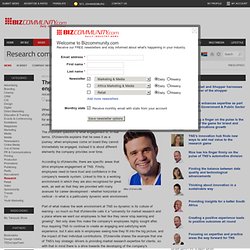
TNS has a history of high staff engagement scores, making it an employer of choice for talent in the market research industry. The important question is what engagement is, in real terms. How employee involvement can make staff want to come to work - Unum. How employee involvement can make staff want to come to work Let’s face it: very few people absolutely love coming to work.
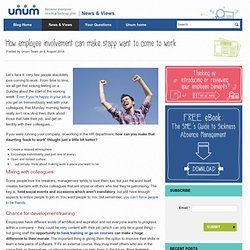
From time to time, we all get that sinking feeling on a Sunday about the start of the working week. What employees really want. What employees really want By Suzan SturholmAll Things HR LLC Employers spend a lot of time concerned about ensuring a happy, productive workforce.
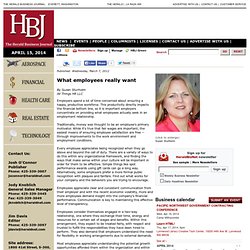
This productivity directly impacts the financial bottom line, so it is important employers concentrate on providing what employees actually seek in an employment relationship. Traditionally, money was thought to be an employee's primary motivator. SAY WHAT?! Why Communication is Key to Employee Engagement. Communication is vital to employee engagement.

All high-performing organizations have great communication and, unsurprisingly, it is a top motivator for employees. Great communication within an organization can be defined as open, consistent, transparent and multi-directional. Employee Engagement: The Not-So-Secret Ingredient in Great Customer Experiences. By Scott Buchanan | Published: April 02, 2014 | Comments A growing number of companies are obsessed with customer experience.
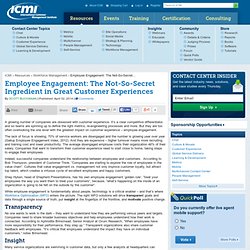
It’s a clear competitive differentiator, and so teams are spinning up to define the right metrics, re-engineering processes and more. But they are too often overlooking the one lever with the greatest impact on customer experience – employee engagement. Want Passionate Employees? Include Them In Your Company Narrative. Inclusion draws upon the two-way nature of real human conversation.
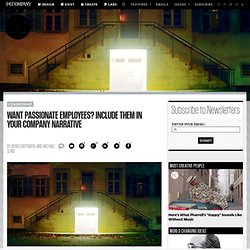
Yet inclusive communication goes a crucial step further: It extends the practice of back-and-forth interaction in a way that entitles people to give as well as take--to provide their own ideas, and not simply to parry the ideas offered by others. Within an organization, the practice of inclusion enables employees not just to interact with managers and colleagues, but also to serve as frontline content providers.
In recent years, as that practice has taken hold at many companies, the overall structure of how organizations develop content has undergone a noticeable shift. Corporate communication professionals, working with other leaders, used to create all or most of the content through which an organization told its story--to internal and external audiences alike. Those professionals developed static messages and built carefully structured campaigns around those messages. Four Questions about "Employee Engagement" How Global Trends Affect Employee Communication and Engagement.
By Scott Spreier, Hay Group.

Energizing Customer-Centric Employees. Motivating Your Yes, No’s and Maybe’s. Not too long ago, I invited a bunch of people to a get together. Thanks to my compulsive nature, I checked the responses daily and happily noticed the small, eager group of people who immediately said “yes,” but frustrated with the vast number of others who said “maybe,” and even more frustrated with the people I never heard from at all.
I get it. We live in a world of many choices. Your Employees are Engaged...REALLY? Discretionary Effort: Is It Really the “Holy Grail” of Engagement? A lot of my work lately has been focused in the area of employee engagement.
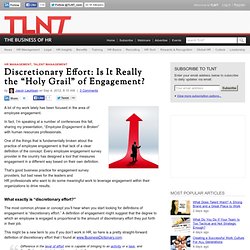
In fact, I’m speaking at a number of conferences this fall, sharing my presentation, “Employee Engagement is Broken” with human resources professionals. One of the things that is fundamentally broken about the practice of employee engagement is that lack of a clear definition of the concept. Every employee engagement survey provider in the country has designed a tool that measures engagement in a different way based on their own definition. Employee Engagement is Dead; Long Live Employee Satisfaction!
« Think Human Responsibility First, Corporate Social Responsibility Second | Home | Build a Culture that Unifies the Corporation »
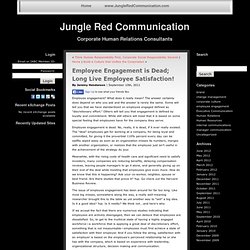
John Cleary: When staff attendance becomes engagement - Business. The average kiwi firm employs 23 per cent of people engaged in building it, whilst 15 per cent are actively degrading it, and 62 per cent are just sleeping through the day.

It is expected to be a golden period for New Zealand this year, in which we expect a growth rate which will catapult us up the OECD chart. Picture this, you are back at your desk, holidays are fading into your distant memory. It's not too hard to picture, because it's a reality. Is your business ready to take advantage of this golden year? Or will you be passed by and sitting in the same position next March. Money: It’s not all employees want. When employers act as though the 1959 song “Money (That’s What I Want)” represents employees’ top priorities in the workplace, they miss some of the most important drivers of satisfaction and engagement.
“It is well known that money is a short-term motivator,” Jayne Mattson, senior vice president, Keystone Associates, told SHRM Online. Ultimately, employees look for an organization and position where their values are met, core skills are utilized and work tasks align with interests, she said. The Best Gift You Can Give Your Employees.
The New Rules of Engagement: How Tech is Energizing Employee Communication. Millennials—and their technology—are changing the workplace in fundamental ways. This coming generation is re-shaping the workforce and the workplace—and it is clear that business management must adapt. Millennials expect to work for organizations that provide work and working conditions that reflect the generation’s interest in community and personal wellbeing. They also expect employees and management to engage in genuine, two-way dialogue. Too many organizations are still giving lip service to their role in improving social or environmental conditions or workplace health.
Employers who are broadcasting generic messages through email, posters in the lunchroom, and productivity-draining meetings are missing the point. There are, however, both messages and tools that can help private and public employers get with a program more suited to attract and retain their employees’ energy and talents. One of the most promising technologies for revamping employee communication is mobile.
Incentive Programs - Engagement - How One Fortune 250 Company Used Internal Marketing to Drive Engagement - Incentive Magazine. Wall Street’s behavior in recent times has undoubtedly given banking and financial companies headaches when it comes to building loyalty. To reestablish trust with consumers, smart brand managers know that any marketing campaign begins from the inside out, with the company employees who are essential in bringing the brand and its message to life. “The financial services industry has been in a difficult period and challenging economy, and that’s changed people’s perspectives,” says Charles Armstrong, vice president of brand management for industry giant Lincoln Financial Group (pictured above).
That was why before Lincoln Financial debuted its new You’re In Charge marketing platform on national TV on Thanksgiving Day, the Fortune 250 firm orchestrated a major internal launch campaign targeting its 8,000 employees. Every new marketing campaign should not only fulfill the external brand promise but also mobilize the organization internally, says Duncan. Getting Employees Vested. Improving Engagement: Do Workers Know the Game You Want Them to Play? One of the biggest frustrations I’ve heard from managers — both middle and senior level executives — is how few employees seem to care about how they, the employee, can help their employer. To them, their employees seem more excited about the upcoming weekend, than they do about making a contribution. In short, their employees act more like “hired hands” than real “players.”
Isn’t It Time to Reconsider the Carrot and Stick Method of Employee Motivation? I like perks and rewards. Who doesn’t like getting a gift card, cash or even a reward trip for working hard? Face-to-face benefits communication can help increase awareness of wellness offerings says Colonial Life. Change is Good: E is for Engagement « The Slalom Blog. August 27, 2012 by Roger Kastner. How Senior Leadership Can Improve Employee Communication.
Too often, corporate managers adopt an outdated approach to employee communications. Instead of conducting thoughtful conversations, senior leadership at many organizations simply rely on standard meetings, memos and presentations to engage with their teams. The importance of integrated employee engagement. Effective integrated employee engagement (IEE) is about understanding your audience, targeting the message and maximising the media.